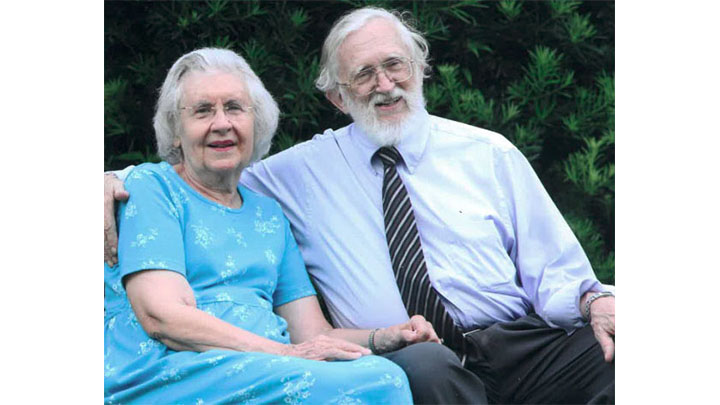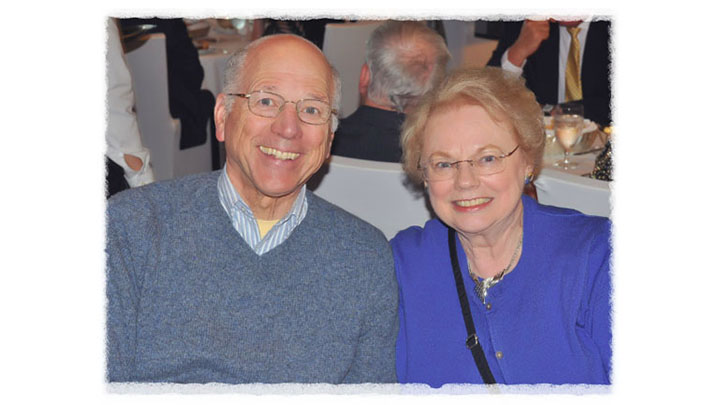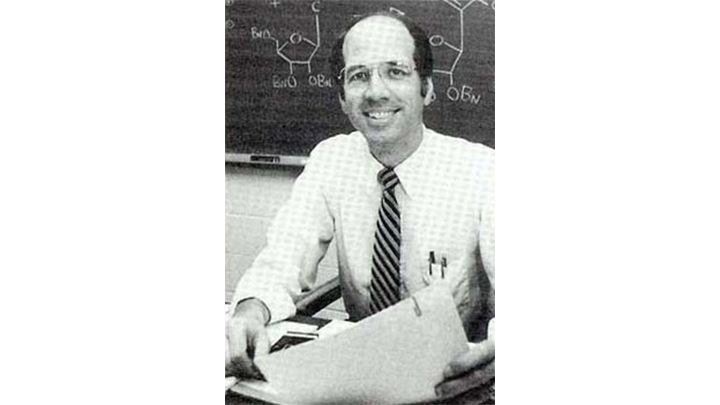About Us
Endowed Lectures
Lecture Series
There are many ways to stimulate growth and to attract favorable attention. One method is hiring faculty with exciting cutting-edge research programs, attracting bright, hard-working, stimulating students, obtaining large amounts of state and non-state funding, and this method is certainly a significant approach.
In addition, the seminar program brings in outside speakers, and these speakers can
provide stimulation and encourage development. One really effective way of simulating
excitement and interest is the creation of an outstanding lectureship series, one
that everyone will take advantage of, and one that will encourage interaction with
external supporters. And one such exemplary program lasted 14 years), as noted in
the following section. When Dr. Stewart Schneller was Director of Graduate Studies,
he initiated an annual lecture series for the Department of Chemistry. In 1983, the
program was initiated through the sponsorship of the Research Council, followed by
support of the R. P. Scherer Corporation. This program co
ntinued for four years and was followed by the Castle Lecture Series.
- * indicates Nobel Laureate
- ** indicates Nobel Laureate after visit
President's Council Lecture Series
- F. Albert Cotton, Ph.D., Robert A. Welch Distinguished Professor of Chemistry Texas A&M "Novel Compounds with Metal-to-Metal Bonds"
- Ronald Breslow, Ph.D., S.I. Professor of Chemistry, Columbia University "Approaches to Artificial Enzymes"
- H. Gobind Khorana, Ph.D.* Alfred P. Sloan Professor of Biology and Chemistry, MIT "Bacteriorhodopsin: A Membrane Protein that Uses Light Energy to Translocate Protons" "Nucleic Acids: Laboratory Synthesis of Genes"
- Fred McLafferty, Ph.D., Professor of Chemistry Cornell University, "Tandem Mass Spectroscopy"
R. P. Scherer 50th Anniversary Chemistry Seminar Series
- Harry Gray, Ph.D., Arnold O. Beckman Professor of Chemistry, California Institute of Technology "Bioinorganic Electron Transfer Mechanisms"
- Barry M. Trost, Ph.D., Vilas Research and Helfaer Professor of Chemistry, Wisconsin "A Pursuit for Selectivity in Organic Synthesis"
- William N. Lipscomb, Ph.D.* Abbott and James Lawrence Professor of Chemistry, Harvard "Allosteric Regulation of Enzymes" "How do Enzymes Work?"
- Melvin Calvin, Ph.D.*, Department of Chemistry, U. California-Berkeley "Photoredox Quantum Conversion" "Renewable Fuels for the Future"
- John A. Pople, Ph.D.**,Department of Chemistry, Carnegie-Mellon "Chemistry as a Computational Science"
- Leo A. Paquette, Ph.D.,Department of Chemistry, The Ohio State University "Ingenane Derivatives–Nature's Tumor Promoters: Synthetic Considerations and Stereochemical Concerns"
- Herbert C. Brown, Ph.D* Wetherill Research Professor Emeritus of Chemistry, Purdue U. "Asymmetric Syntheses via Chiral Organoboranes" "Adventures in Research"
- Fred Basolo, Ph.D., Morrison Professor of Chemistry, Northwestern U. "Mechanisms of Reactions of Metal Carbonyls Revisited"
- Klaus Bieman, Ph.D., Professor of Chemistry, MIT "Mass Spectrometric Studies of Biologically Significant Large Molecules"
Gardinier Lecture
Garry A. Rechnitz, Ph.D. Unidel Professor of Chemistry and Biotechnology "Molecular Recognition Elements for Biosensor Design"
Castle Chemistry Lectures
- Rolf Huisgen, Ph.D., Professor of Chemistry ,Universität München "New Reactions in Organic Sulfur Chemistry" "Stereospecificity and Reaction Mechanism"
- M. Frederick Hawthorne, Ph.D., Professor of Chemistry, UCLA "Studies in Metallacarborane Chemistry"
- R. Bruce Merrifield, Ph.D.,*, John D. Rockefeller , Jr. Professor Rockefeller University "Solid Phase Peptide Synthesis: Some New Developments in the Chemistry" "The Study of Biologically Active Peptides by Chemical Synthesis"
- Mark S. Wrighton, Ph.D., Frederick G. Keyes Professor of Chemistry, MIT (Later, president,Washington U.) "Surface Chemistry of Microfabricated Structures: Molecule Based Electronic Devices"
- Kendall N. Houk, Ph.D., Professor of Chemistry, UCLA "Theory and Modeling of Stereoselective Organic Reactions"
- Josef Michl, Ph.D.,Collie-Welch Professor of Chemistry, University of Texas "Fast Particle Bombardment of Solid Nitrogen: What is Going On?"
- Derek H.R. Barton, Ph.D. * Department of Chemistry, Texas A&M "The Invention of Chemical Reactions" "How to Win a Nobel Prize: A Personal Case History"
- James A. Ibers, Ph.D. Morrison Professor of Chemistry, Northwestern University "Transition Metal Chalcogenides in the Solid State and in Solution"
- Richard H. Holm, Ph.D.. Higgins Professor of Chemistry, Harvard University "Biologically Relevant Atom Transfer Chemistry of Molybdenum: From Synthetic Analogues to Enzymes"
- Gertude Elion*, Burrows Welcome (later SmithKlineGlaxo) "Antiviral Agents: The Search for Selectivity" "The Purine Path to Chemotherapy"
- John D. Baldeschwieler, Ph.D., Professor of Chemistry, California Institute of Technology "The Use of Phospholipid Vesicles in Cancer Diagnosis and Therapy"
- Koji Nakanishi, Ph.D., Centennial Professor of Chemistry, Columbia U. "Why is 11-cis Retinal the Chromophore for Vision?"
- Harold Scheraga, Ph.D., Todd Professor of Chemistry, Cornell University "Conformational Energy Calculations on Polypeptides and Proteins"
- Jerome Karle, Ph.D.,* The Naval Research Laboratory "Applications of Structural Analysis to Chemistry" "Science in the Real World"
- Herbert Hauptman, Ph.D.*, Medical Foundation of Buffalo "The Phase Problem of X-ray Crystallography" "The History and Unexpected Importance of X-ray Crystallography"
- Ignacio Tinoco, Jr., Ph.D., Professor of Chemistry, University of California-Berkeley "The Structure of an RNA Molecule–Differing Views from NMR and X-ray Crystallography"
- Nicholas Turro, Ph.D., Schweitzer Professor of Chemistry, Columbia U. "Organic Chemistry in Restricted Reaction Space. The Underpinnings of Molecular Recognition"
- George Hitchings, Ph.D. *,The Wellcome Research Laboratories (later SmithKlineGlaxo) "Analogs of DNA Bases, Applications in the Treatment of Infectious Diseases"
- Marye Anne Fox, Ph.D., Waggoner Professor of Chemistry. University of Texas-Austin "Three Dimensional Systems for Controlled Electron Transfer"
- Richard E. Smalley, Ph.D. **Hackerman Professor of Chemistry, Rice University "C60 and the Emerging Carbon-Based Nanotechnology"
- John Polanyi, Ph.D.*, Department of Chemistry, University of Toronto "Surface Aligned Photochemistry" "The Molecular Dance in Chemical Reactions and Why It Matters"
- Amos Smith, III, Ph.D., Rhodes-Thompson Professor of Chemistry, University of Pennsylvania "The De Novo Design, Synthesis, and X-Ray Crystal Structures of Pyrrolinone Based β-Non-peptide Peptidomimetics"
- W. Wallace Cleland, Ph.D., Johnson Professor of Chemistry and Steenbock Professor of Chemical Science, Department of Chemistry, University of Wisconsin "What Makes Enzymatic Reactions So Fast?"
The program was very successful because of Dr. Schneller's leadership and the selection of speakers. Typically three areas of chemistry would be represented, and one lecturer would be a Nobel Laureate. The latter lecture would be coordinated with the Department's Open House, typically in the fall. High school and college students would be invited to attend. The Laureate would present a technical lecture on Friday afternoon, following a luncheon, and then there would be an opportunity for all to meet the visitor at a reception typically held atop the Student Services Building. On Saturday morning, college and high school students would be invited to attend the open house. Coffee, juice, and donuts would be served in the atrium of the Chemistry Building, and graduate students and faculty would participate in a poster session. Guided tours of the Chemistry facilities were coordinated with graduate students serving as tour guides. Then the Laureate would present a more general lecture in CHE 100, and this would be followed by lunch for all. High school students and their teachers would be invited to have lunch with the Laureate by themselves in a separate room. After lunch, college student visitors would be given tickets to Busch Gardens.
This program took considerable planning by Dr. Schneller, and he did it very well, presumably with the assistance of Ms. Dyane Chapman and Mrs. Schneller. Few could appreciate how much effort was involved. But one example comes to mind of a speaker who shipped his own large screen which was guaranteed to be flat so there would be no distortion in the projected slides for a three-dimensional effect. Of course, the screen had to be acquired from Central Receiving (in its own shipping box) by Dr. Schneller, hauled over to Chemistry, manhandled down to the basement of CHE 100, hidden away until the proper time, and installed by Physical Plant personnel. And, of course, the entire process had to be reversed after the speaker left.
This series was a powerful recruiting tool, and it was a powerful tool for establishing USF Chemistry Department in the eyes of those outside Florida. Nobel Laureates who came included Herbert C. Brown (Purdue University), Melvin Calvin (University of California-Berkeley), and William Lipscomb (Harvard). All gave impressive presentations.
And so did the other lecturers in this series (and the subsequent series), who may not have been Nobel Laureates, but were superb chemists. Professor Harry Gray, Cal Tech, participated in the program, gave an inspiring lecture, and was a delightful guest. So was Professor Fred Basolo (Northwestern University), former President of the American Chemical Society, who gave an impressive lecture to a class of general chemistry students. Other inorganic chemists included the late Professor Al Cotton (Texas A&M) an ACS presidential candidate at the time, and Professor Frederick Hawthorne (UCLA), Editor of Inorganic Chemistry, and Professor Richard Holm.
Unfortunately, the fine tradition and the considerable momentum that had been established by the program was in danger of being lost when the grant from R. P. Scherer expired.
Fortunately, Dr. Schneller was able to convince Dr. and Mrs. Raymond N. Castle to continue the lecture series at full scale. Through their generosity, the series continued starting in 1987 until Dr. Castle retired in 1994. When interviewed about their decision to support the series after the grant from R. P. Scherer expired, Professor Castle was quoted as saying, "This is an important program for the Chemistry Department. It already has a strong following, and we would lose valuable momentum if the series was to be interrupted".
Dr. Castle added, "The visibility and recognition the University receives is important. Furthermore, it gives our students the chance to listen to and be stimulated by the world's outstanding chemists".
Raymond Castle had joined the USF Chemistry faculty in 1981 as a Graduate Research Professor. He was born June 24, 1916 in Boise, Idaho and as graduated from the University of Idaho, Southern Branch, Pocatello in 1938 with a degree in pharmacy. He then completed the M.A. degree requirements in Chemistry at the University of Colorado (1941), and following a stint as a Chemistry instructor at the University of Idaho, he returned and earned a Ph.D. (1944) at the University of Colorado. He came to USF following two years as a research Chemist at Battelle Memorial Institute (Columbus, Ohio), as a faculty member for 24 years at the University of New Mexico, and 11 years at Brigham Young University.
He and his wife, Ada, were a treasured part of the Department of Chemistry where he did research and where they together were responsible for the publication of the Journal of Heterocyclic Chemistry, which he had founded in 1964, and continued to serve as editor.
He was well regarded as a speaker and gave lectures around the world. He was a much honored chemist, including the International Award in Heterocyclic Chemistry (1983), presented in Tokyo, in recognition of his outstanding contributions to the field. He once said, "I'm not going to retire, I'm going to drop." He had just returned from an International Congress on Heterocyclic Chemistry and was planning his work for the next day when he died quietly at home in the summer of 1999.
The Department of Chemistry's Annual Raymond Castle Undergraduate Research Conference was initiated in his memory in 2001.
Martin Seminar Series
When Raymond Castle retired in 1994, the Castle lecture series was terminated, and was replaced in a limited way by the Barbara and Dean Martin Seminar Series. These lectures, too, were designed to provide an opportunity for a diverse group of outstanding persons. At the outset, a guarantee of funding for five years was promised, but the program was successful and continued beyond the five-year program.

In 2013, the program was covered by an ad hoc Endowed Lecture committee consisting of Drs. Jiangfeng Cai (Chair), Xi (Cheryl) Li, Santiago Sandi-Urena, and Peter Zhang. Subsequently. The committee was made a standing committee of the department.
Dick van der Helm, Ph.D., George Lynn Cross Research Professor, University of Oklahoma "Iron Uptake by Siderophores in Microorganisms and the Physical Chemistry of Ferric Siderophore Receptor Proteins"
- Robert P. Carnahan, Ph.D., P.E., Professor of Civil Engineering and Mechanics, USF "Advances in Water Treatment Technology"
- Daryle H. Busch, Ph.D. Roy A. Roberts Distinguished Professor, University of Kansas "Ligand Design for Enhanced Molecular Organization"
- Jon C. Clardy, Ph.D., Horace White Professor of Chemistry, Cornell University "Natural Products and Their Targets"
- Marcetta Y. Darensbourg, Ph.D. Professor of Chemistry, Texas A&M University "Chemical Models for the Heterobimetallic Active Site of NiFe HydrogenaseB An Organometallic in Biology"
- Robert E. Sievers, Ph.D., Professor, Department of Chemistry & Biochemistry, University of Colorado "Fine Aerosol Particles in Pulmonary Drug Delivery and in the Atmosphere"
- Steven D. Burke, Ph.D. Professor, Department of Chemistry, University of Wisconsin-Madison "Synthesis and Study of Natural and Unnatural Oxacycles"
- Margaret Farago, Ph.D., Professor, Centre for Environmental Technology, Imperial College of Science, Technology and Medicine, University of London "Arsenic Contamination in Southwest England"
- Peter C. Jurs, Ph.D., Professor, Department of Chemistry, The Pennsylvania State University "Prediction of Chemical Properties of Organic Compounds from Molecular Structures"
- Albert Padwa, Ph.D., William P. Timmie Professor, Department of Chemistry, Emory University "Cascade Processes for Alkaloid Synthesis"
- Gregory R. Choppin,Ph.D., Professor,Department of Chemistry, The Florida State University "Environmental Behavior of Plutonium"
- Stewart W. Schneller, Ph.D. Dean, College of Sciences and Mathematics, Auburn "Carbocyclic Nucleosides"
- Ellen M.Leahy, Ph.D. Senior Scientist, Medicinal Chemistry, Celera
- James W. Leahy, Ph.D. Directory of Chemistry, Exelixis "Drug Discovery in the Post-Genomic Era"
- Dale W. Margerum, Ph.D. Harvey Washington Wiley Distinguished Professor of Chemistry Purdue University "Diversity of Bromite Ion Redox Mechanisms in Aqueous Solutions"
- Joanna Fowler, Ph.D. Brookhaven National Laboratory "Imaging Drug Addiction in the Human Brain"
- Margaret M. Faul, Ph.D. Associate Director, Chemical Process R&D Amgen, Inc. "Process Development Towards the Synthesis of Protein Kinase C Inhibitors"
- Frank W. Fowler, Ph.D. Professor of Chemistry, SUNY-Stony Brook "The Development of Strategies for the Preparation of Designed Materials"
Patrick Benz, ( PhD.'76) President, Benz Research and Development "Contemporary Topics in Contact Lens and Intraocular Lens Materials"
Brian Moulton (Ph.D. '03) Vertex Pharmaceuticals "Translational Product Development in the Pharmaceutical; Industry: Discovery and Development"
Joseph S. Francisco, Ph.D. William E. Moore Distinguished Professor of Chemistry and Earth and Atmospheric Sciences, Purdue University "Earth's Atmosphere to Planetary Engineering of Mars: An Adventure in Chemistry."
Stephen Leffler Buchwald, Ph.D Camille Dreyfus Professor of Chemistry, MIT "Palladium and Copper-Catalyzed Methodology of Use in Organic Synthesis: From Fundamentals to Applications"
Melanie Cooper, Ph.D. Lappan-Phillips Chair of Science Education "Evidence-Based Approaches to Curriculum Reform and Assessment"
The Schneller Chemistry Legacy Lectureship will host one lecture per year within the Chemistry Department. The Schneller Legacy Lecturer is to be chosen by the chemistry department chair in consultation with appropriate faculty members forming a committee. Each Schneller Chemistry Legacy Lecturer will receive a plaque recognizing his/her lecture.

Stew Schneller served as a member of the USF chemistry faculty from 1971-1994 that included being chair of the department from 1986-1994.
This Schneller Chemistry Legacy Lectureship honors the chemistry faculty who, from 1960 to 1968, traveled from sand spurs and gravel roads to arrive at a Ph.D. granting department with an undergraduate degree program consistently recognized by the American Chemical Society.
If I have seen further than others, it is by standing upon the shoulders of giants.
~Isaac Newton
Eric N. Jacobsen, Ph.D., Sheldon Emory Professor and Chair Department of Chemistry & Chemical Biology, Harvard University "Anion-Binding Catalysis"
Andrew Hamilton, Ph.D. Professor of Chemistry and 16th President New York University "Synthetic Mimics of Protein Structure and Function"
Jeffrey N. Johnson, Ph.D. Stevenson Professor of Chemistry, Vanderbilt University, s “New Catalysts, Methods, and Strategies for Therapeutic Development and On Demand Natural Product Total Synthesis.”
Sarah E. Reisman, Ph.D. Professor, California Institute of Technology
“From Alkaloids to Terpenoids: New Strategies and Tactics for the Synthesis of Polycyclic
Natural Products”
